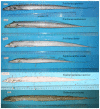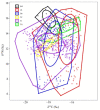Species Composition, Growth, and Trophic Traits of Hairtail (Trichiuridae), the Most Productive Fish in Chinese Marine Fishery
- PMID: 36428306
- PMCID: PMC9687022
- DOI: 10.3390/ani12223078
Species Composition, Growth, and Trophic Traits of Hairtail (Trichiuridae), the Most Productive Fish in Chinese Marine Fishery
Abstract
Hairtail (Scombriformes: Trichiuridae) have always ranked first in single-species production in Chinese marine fishery. However, due to the confusion of species identification, in official statistics, data on hairtail production and economic value are a combination of all the different species of Trichiuridae. In this study, based on sampling along China's coastal areas, the composition and distribution of common hairtail species, as well as their age, growth, and trophic traits, are discussed. Six species of four genera and two subfamilies were identified, and largehead hairtail (Trichiurus japonicus) and Savalai hairtail (Lepturacanthus savala) were the most important populations that constituted catch production. The growth parameter b could be divided into two groups, with values in species mostly inhabiting northern parts of Chinese seas higher than those in southern parts. Most individuals were 1-2 years of age, suggesting species sexual precocity and individual miniaturization under multiple stresses. Species of Trichiuridae are at the top of the food web and play a bottom-up role in regulating the trophic dynamics of marine food webs. Largehead hairtail showed the highest stability and the greatest impact on the stability of the trophic structure. Despite temporary resource maintenance under fishery-induced evolution, the effective recovery and reasonable utilization of hairtail resources are still the main focuses of attention for Chinese marine fishery.
Keywords: distribution; otolith; stable isotope; taxonomy; trophic level.
Conflict of interest statement
The authors declare no conflict of interest.
Figures











Similar articles
-
Heavy Metal Concentration in Largehead Hairtail (Trichiurus lepturus Linneaus, 1758) and Savalai Hairtail (Lepturacanthus savala (Cuvier, 1829)) Obtained from Karachi Fish Harbour, Pakistan.Bull Environ Contam Toxicol. 2018 Oct;101(4):467-472. doi: 10.1007/s00128-018-2418-1. Epub 2018 Aug 16. Bull Environ Contam Toxicol. 2018. PMID: 30116849
-
Stable isotopic and stomach content analyses reveal changes in the trophic level and feeding habit of large-head hairtail (Trichiurus lepturus) in the northern South China Sea.Sci Total Environ. 2023 Oct 20;896:165313. doi: 10.1016/j.scitotenv.2023.165313. Epub 2023 Jul 4. Sci Total Environ. 2023. PMID: 37406705
-
The complete mitogenome of the Lepturacanthus savala (Perciformes: Trichiuridae) from the Yellow Sea.Mitochondrial DNA B Resour. 2020 Jul 15;5(3):2815-2816. doi: 10.1080/23802359.2020.1789512. Mitochondrial DNA B Resour. 2020. PMID: 33457959 Free PMC article.
-
The marine food chain in relation to biodiversity.ScientificWorldJournal. 2001 Oct 19;1:579-87. doi: 10.1100/tsw.2001.85. ScientificWorldJournal. 2001. PMID: 12805852 Free PMC article. Review.
-
The northern shrimp (Pandalus borealis) offshore fishery in the Northeast Atlantic.Adv Mar Biol. 2007;52:147-266. doi: 10.1016/S0065-2881(06)52002-4. Adv Mar Biol. 2007. PMID: 17298891 Review.
Cited by
-
Whole-Genome Sequencing Analyses Reveal the Whip-like Tail Formation, Innate Immune Evolution, and DNA Repair Mechanisms of Eupleurogrammus muticus.Animals (Basel). 2024 Jan 29;14(3):434. doi: 10.3390/ani14030434. Animals (Basel). 2024. PMID: 38338077 Free PMC article.
References
-
- FAO . The State of World Fisheries and Aquaculture 2018. Food and Agriculture Organization of the United Nations, Fisheries and Aquaculture Department; Rome, Italy: 2018.
-
- Fishbase. [(accessed on 10 August 2022)]. Available online: http://www.fishbase.org/search.php.
-
- China Fishery Bureau . China Fishery Statistical Yearbook. China Agriculture Press; Beijing, China: 2020. p. 39.
-
- Liu M., Sadovy de Mitcheson Y. Profile of a fishery collapse: Why mariculture failed to save the large yellow croaker. Fish Fish. 2008;9:219–242. doi: 10.1111/j.1467-2979.2008.00278.x. - DOI
Grants and funding
LinkOut - more resources
Full Text Sources

